ESP off MERCEDES-BENZ E-Class SEDAN 2017 W213 User Guide
[x] Cancel search | Manufacturer: MERCEDES-BENZ, Model Year: 2017, Model line: E-Class SEDAN, Model: MERCEDES-BENZ E-Class SEDAN 2017 W213Pages: 446, PDF Size: 6.23 MB
Page 96 of 446
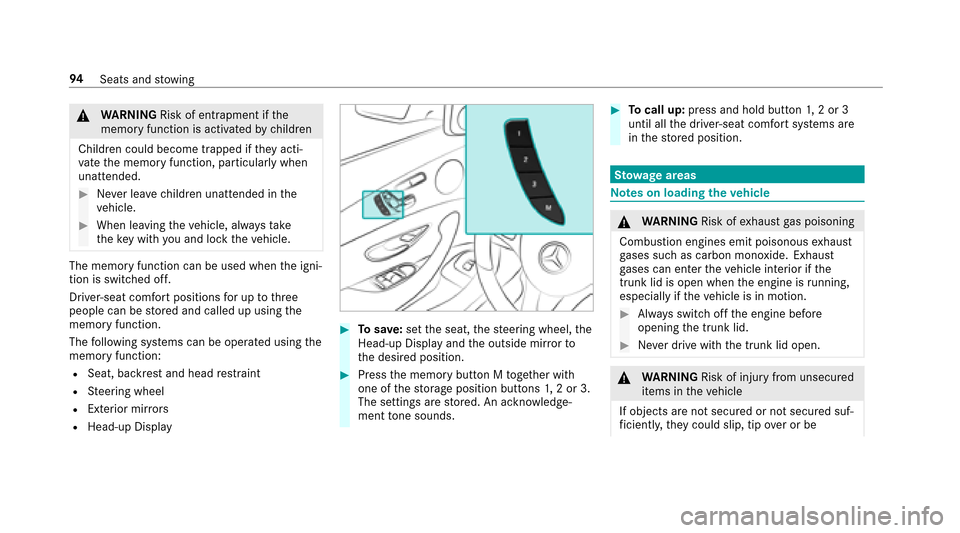
&WARNING Risk of entrapment if the
memor yfunction is activated bychildren
Children could becom etrapped if they acti‐
va te them emor yfunction ,particularly when
unattended.
#Ne verlea ve children unatte ndedint he
ve hicle.
#When leaving thev ehicle, alw ayst ake
th ek eywit hyou and loc kthe vehicle.
The memor yfunction can be used when thei gni‐
tion is switched off.
Driver-seat comfor tposition sfor up tothre e
people can be stored and called up using the
memor yfunction.
The following sy stems can be operated using the
memor yfunction:
RSeat, backres tand head restra int
RSt eering wheel
REx terior mir rors
RHead-up Display
#To save :se tthe seat, thes teering wheel, the
Head-up Displa yand theo utside mir rort o
th ed esired position.
#Press them emor ybutton Mtogether with
one of thes torage position buttons 1,2or3 .
The settings ar estore d. An acknowledge‐
ment tone sounds.
#To call up: press and hold button 1,2or3
until al lthe driver-seat comfor tsystems are
in thes tore dp osition.
Stow agea reas
Note sonl oading thev ehicle
&
WARNING Risk ofexhaus tgas poisoning
Combustio nengines emit poisonous exhaust
ga ses suc hascarbon monoxide. Exhaust
ga ses can enter thev ehicle interior if the
trunk li disopenw hent he engine is running,
especial lyifth ev ehicle is in motion.
#Alw ayss witc hoffthee ngine before
opening thet runk lid.
#Ne verd rive wit hthe trunk lid open.
&
WARNING Risk of injury from unsecured
items in thev ehicle
If object sarenots ecured or no tsecured suf‐
fi cientl y,they could slip, tip over or be
94
Seats and stowing
Page 110 of 446

#Alwaysm akes uret hat objectsdon ot
pr otru de from stowages paces, luggage
nets or stowagen ets.
#Close thel oc kable stow ages paces
befor estarti ngajou rney .
#Alw ayss towa nd secur eheavy ,hard,
pointe d, sharp-edged, fragile or bulky
objects in thet runk/load compartment.
Obser vethen otes on loading thev ehicle.
&
WARNING Risk offire from placing
objects in them obile phone stowage
compartment
If yo up laceo bject sint he mobile phone
stow agec ompartment ,the ym ayheat up
exc essively and evencatc hfire.
#Do no tplace additional objects ,espe‐
cially those mode of me tal, in the
mobilep honestowagec ompartment.
* NO
TEDama getoobject scaused by
placing them in them obile phone stow‐
ag ec ompartment
Ifyo up laceo bjectsinthestow agec ompart‐
ment, these ma ybedamaged byelectromag‐
netic fields.
#Do no tplace credit cards, storage
media or other objectss ensitiveto
electromagnetic fields in them obile
phone stowagec ompartment.
#Do no tspill liquids int othe mobile
phone stowagec ompartment.
Requirements:RYour mobile phonem ustbes uitable forw ire‐
less charging( Qi-compatible mobile phone).
RDependingont hevehicle equipment, the
mobilep hone is connected tothev ehicle's
ex terior antenna via thec harging module.
RThe chargingf unction and wireless connec‐
tio noft he mobile phone tothev ehicle's
ex terior antenna ar eonlya vailable if thei gni‐
tion is switched on.
RTo ensur emoree fficient charginga nd con‐
nectio nwitht he exterior antenna, remo ve
th ep rotectiv ecover from them obile phone.
RSmall mobile phones ma ynotbe able tobe
ch arge dine very position of thes towa ge
compartment.
RLar gemobil ephones whic hdonotfiti nt ot he
stow agec ompartment ma ynotbe able tobe
ch arge dorc onnec tedw itht he exterior
antenna.
10 8
Seats and stowing
Page 112 of 446
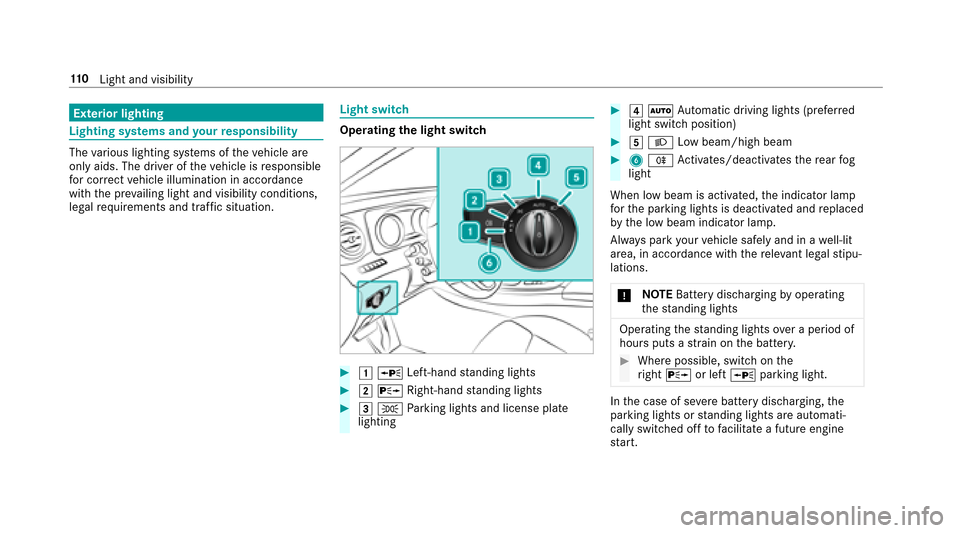
Exterior lighting
Lighting systems and your responsibility
The various lighting sy stems of thev ehicle are
onl yaids. The driver of thev ehicle is responsible
fo rc orrect vehicle illumination in accordance
wit hthe pr evailing light and visibilityc onditions,
legal requirements and traf fics ituation.
Light switch
Opera tingthe light switch
#1 W Left-hand standing lights
#2 X Right-hand standing lights
#3 T Parking lightsa nd license plate
lighting
#4 Ã Automatic driving lights (prefer red
light switc hposition)
#5 L Lowb eam/high beam
#6 R Activates/deacti vatest he rear fog
light
When lo wbeam is activated, thei ndicator lamp
fo rt he parking lights is deactivated and replaced
by thel ow beam indicator lamp.
Alw aysp arky our vehicle safely and in awell-lit
area, in accordance wit hthe releva nt le galstipu‐
lations.
* NO
TEBatter ydisch arging byoperating
th es tanding lights
Operatin gthe standing lightso verap eriod of
hour sputs astrai nont he batter y.
#Wherepossible, switc honthe
ri ght X or left Wparking light.
Inthec ase of se vere batter ydischarging, the
parkin glights or standing lightsa reautomati‐
call yswitch ed offtofacilitat eafutureengine
st art.
11 0
Light and visibility
Page 113 of 446
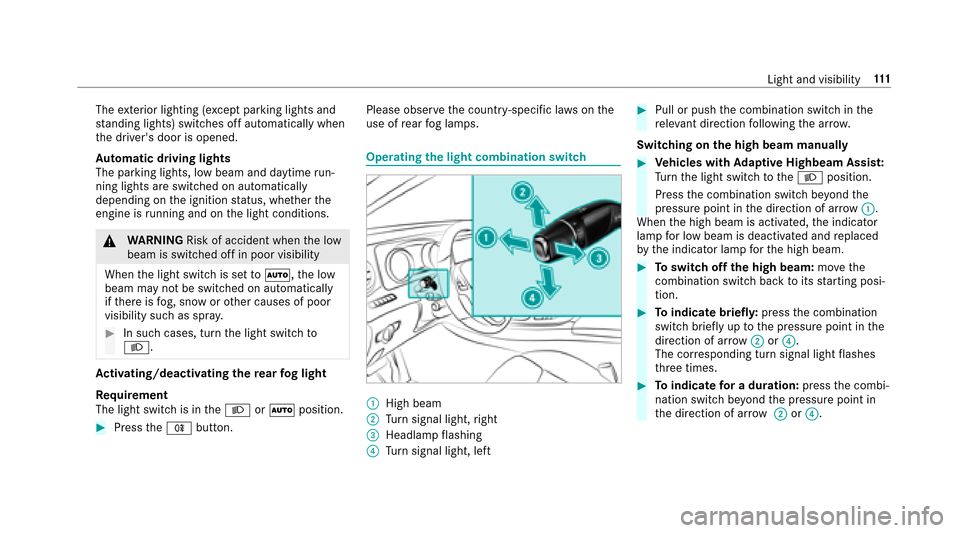
Theexterior lighting (e xcep tp arking lights and
st anding lights) switch es offautomaticall ywhen
th ed rive r's door is opened.
Au tomatic drivin glights
The pa rking lights, lo wbeam and daytime run‐
ning lights ar eswitched on au tomatically
depending on thei gnition status ,whether the
engine is running and on thel ight conditions.
&
WARNING Risk of accident whe nthe low
beam is switched of finpoor visibility
When thel ight switc hissetto Ã,t he low
beam ma ynotbe switched on automatically
if th er eisf og, sno worother causes of poor
visibility suc hasspray .
#In suc hcases, tur nthe light switc hto
L.
Ac tivating/deactivatin gthe rear fogl ight
Re quirement
The light switc hisintheL orà position.
#Press theR button. Please obser
vethec ountry -specific la wsonthe
use of rear fogl amps.
Operating thel ight combination switch
:High beam
;Turn signal light, right
=Headlam pflashing
?Turn signal light, left
#Pull or push thec ombination switc hinthe
re leva nt di rection following thea rrow .
Switching on theh igh beam manually
#Vehicles with Adaptiv eHighbeam Assis t:
Tu rn thel ight switc htotheL position.
Press thec ombination switc hbeyond the
pressur epoint in thed irection of ar row:.
When theh igh beam is activated, thei ndicator
lam pfor lo wbeamisd eactivated and replaced
by thei ndicator lam pfor theh igh beam.
#Toswitc hofftheh igh beam: movethe
combination switc hbacktoi tsstartin gposi‐
tion.
#To indicat ebriefl y:press thec ombination
switc hbriefly up tothep ressur epoint in the
direction of ar row;or?.
The cor responding tur nsignal light flashes
th re et imes.
#To indicat efor ad uration: pressthe combi‐
nation switc hbeyond thep ressur epoint in
th ed irection of ar row;or?.
Light and visibility 111
Page 115 of 446
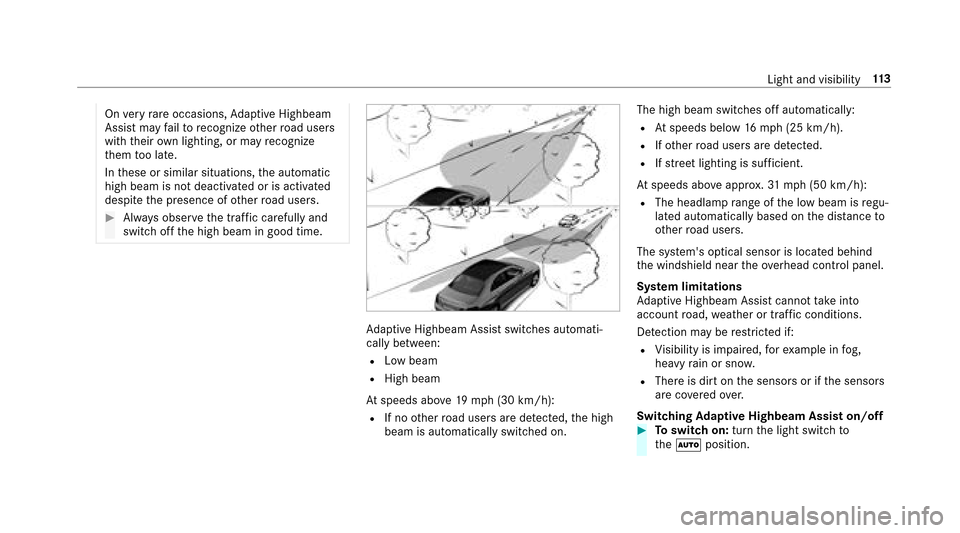
Onvery rare occasions, Adaptiv eHighbeam
Assis tmayfailto recognize other road users
wit htheir ownlighting, or ma yrecognize
th em tool ate.
In these or similar situations, thea utomatic
high beam is no tdeactivated or is activated
despit ethe presence of other road users.
#Alw ayso bser vethet raffic carefull yand
switc hofftheh igh beam in good time.
Adaptiv eHighbeam Assis tswitch es automati‐
cally between:
RLo wb eam
RHigh beam
At speeds abo ve19 mp h(30 km/h):
RIf no other road user saredetected, theh igh
beam is automaticall yswitched on. The high beam switches of
fautomatically:
RAt speeds belo w16mph (25 km/h).
RIfot her road user saredetected.
RIfstre et lighting is suf ficient.
At speeds abo veappr ox.31m ph (50 km/h):
RThe headlam prang eoft he lowbeam is regu‐
lated automatically based on thed ista nce to
ot her road users.
The sy stem's optical sensor is located behind
th ew indshield near theo verhead control panel.
Sy stem limitations
Ad aptiv eHighbeam Assis tcanno ttak ei nto
account road, weather or traf ficc onditions.
De tection ma yberestricted if:
RVisibility is impaired, fore xamp le infog,
heavy rain or sno w.
RThereisd irtont he sensor sorifthe sensors
ar ec overed over.
Switching Adaptiv eHighbeam Assis ton/off
#To switc hon:tur nthe light switc hto
th eà position.
Light and visibility 11
3
Page 121 of 446

#Use button2tosetthe position of them ir‐
ro ry ou ha veselected.
An outside mir rorw hich has been pushed out of
position can be engaged in position again in the
fo llowing manner:
#Ve hicles without electrical lyfolding out‐
side mir rors:Manually mo vetheo utside
mir rorint ot he cor rect position.
#Ve hicles with electrical lyfolding outside
mir rors:Press and hol dbutton1.
Yo uw illhear aclicka nd them irro ra udibly
engag einposition .The mir roriss etintot he
cor rect position.
Au tomatic anti-glar emirrors
&
WARNING Risk of burn sand poisoning
due toelectrolyt eofthe anti-glar emirro r
Electrolyte mayescap eiftheglass in an
automatic anti-glar emirro rb reaks.
The electrolyt eisharmful and causes ir rita ‐
tion. It must notc ome int ocontact wi thyour
skin, eyes,respirator yorgans or clo thing or
be swallo wed.
If yo uc om eintoc ontact wit he lectrolyte,
observ ethe following:
RRinse thee lectrolyt efromy our skin and
seek medical attention immedia tely.
RIf electrolyt ecomes int ocontact with
yo ur eyes, rinse them thoroughly with
clean waterand seek medicala ttention
immediatel y.
RIfth ee lectrolyt eisswallowe d, immedi‐
ately rinse your mout houtthoroughl y.Do
no tinduce vomiting. Seek medica latten‐
tion immediately.
RImmediate lych ang eout of clo thing which
has com eintoc ontact wi thelectrolyte.
RIf an allergic reaction occurs, seek medi‐
cal attention immediatel y.
The outside and insiderearvie wmirro rs on the
driver's side automatically go int oanti- glare
mode if light from aheadlam phitst he inside
re arvie wmirro r. Sy
stem limitations
The mir rors do no tgointoa nti- glar em ode in the
fo llowing situations:
RThe engin eisswitched off.
RThereve rseg ear is engaged.
RThe interior lighting is switched on.
Parking position of thep assenger outside
mir ror
The parking position makes parking easier.
The passenger outside mir rort ilts down wards
and sho wsther ear wheel on thef ront passenger
side if:
RThe parking position is stored
RThe passenger mir roriss elected
RAndther eve rseg ear is engaged.
The passenger outside mir rorm oves bac ktoits
original position in thef ollowing situations:
RIfyo us hiftthe transmission toano ther trans‐
mission position
RIf yo ud rive fast erthan 15 km/h
Light and visibility 11
9
Page 151 of 446
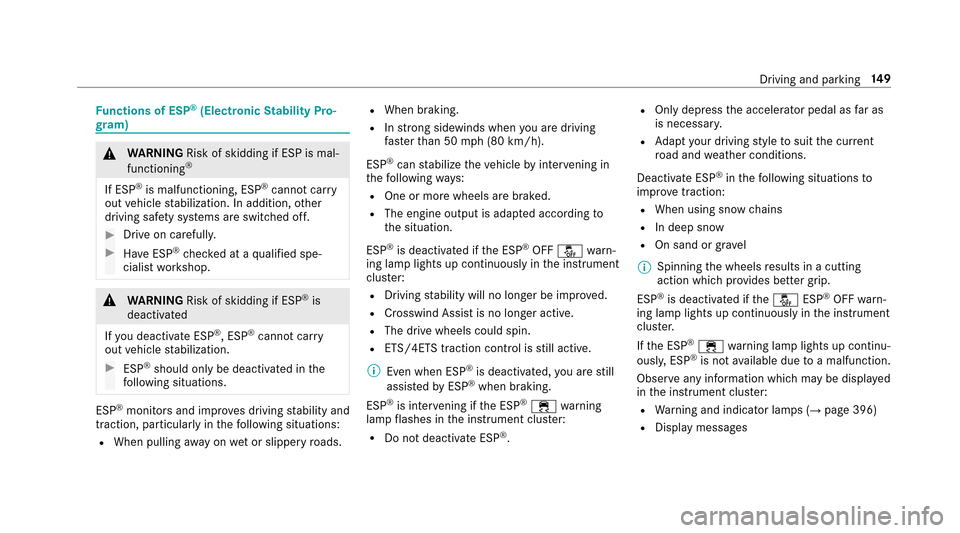
Functions of ESP®(Electronic Stability Pro‐
gr am)
&
WARNING Risk of skidding if ESP is mal‐
functioning®
If ESP®is malfunctioning ,ESP®canno tcarry
out vehicle stabilization. In addition,o ther
driving saf etys ystems ar eswitched off.
#Driv eonc arefull y.
#Have ESP®checkedataq ualified spe‐
cialis tworks hop.
&
WARNING Risk of skidding if ESP®is
deactivated
If yo ud eactivat eESP
®,ESP®canno tcarry
out vehicle stabilization.
#ESP®shouldo nly be deacti vatedint he
fo llowing situations.
ESP®monitor sand impr oves driving stabilitya nd
traction,p articularly inthef ollowing situations:
RWhen pullin gawayonw etor slippe ryroads.
RWhen braking.
RIn stro ng sidewinds when youa redrivin g
fast erthan 50 mph(80 km/h).
ESP
®can stabilizet hevehicle byinter vening in
th ef ollowing ways:
ROne or mor ewheels ar ebrake d.
RThe engine output is adap teda ccording to
th es ituation.
ESP
®is deactivated if theE SP®OFF å warn‐
ing lam plightsupc ontinuousl yinthe instrument
clus ter:
RDriving stabilityw ill no longe rbeimprove d.
RCrosswind Assis tisnolonger active.
RThe driv ewheels could spin.
RETS/4ET Straction control is still active.
% Even when ESP
®is deactivated, youa restill
assis tedbyE SP®when braking.
ESP
®is inter vening if theE SP®÷ warning
lam pflashes in thei nstrument clus ter:
RDo no tdeacti vate ESP®.
ROnly depress thea ccelera torp edalasf ar as
is necessar y.
RAdapty our driving styletos uitthec urrent
ro ad and weather conditions.
Deactivat eESP
®inthef ollowing situations to
impr ovetraction:
RWhen using sno wchains
RIn deep snow
ROn sand or gr avel
% Spinning thew heels results in acutting
action whic hprovide sbette rg rip.
ESP
®is deactivated if theå ESP®OFFwarn‐
ing lam plightsupc ontinuousl yinthe instrument
clus ter.
If th eE SP
®÷ warning lam plightsupc ontinu‐
ousl y,ESP®is no tavailable due toam alfunction.
Observ eanyinformation whic hmaybe displa yed
in thei nstrument clus ter:
RWa rning and indicator lamps (→pag e396)
RDispla ymessages
Drivinga nd parking 14
9
Page 154 of 446

Activating/deactivatin gESP®(Electronic Sta‐
bility Prog ram)
Multimedia sy stem:,Vehicle.k Assistance.ESP
#Activate Oor deacti vate ª thef unction.
ESP
®is deactivated if theE SP®OFF å warn‐
ing lam plightsupc ontinuousl yinthe instrument
clus ter.
Obser vethei nformation on warning lamps and
displa ymessages whic hmaybe shown in the
instrumentc luster.
Fu nctions of ESP®Crosswind Assist
ESP®Crosswind Assis tdetects sudden gusts of
side wind and helps thed rive rtok eepthev ehi‐
cle in thel ane:
RESP®Crosswind Assis tisactiveatv ehicle
speeds between 50 mph(80 km/h) and
12 5m ph (200 km/h) when driving stra ight
ahead or cornering slightly.
RThe vehicle is stabilized bymeans of individ‐
ua lb rake application on one side.
Function of EBD (Electronic Brak eforce Dis‐
tribution)
EB Disc haracterized bythef ollowing:
RMonitoring and closed-loop control of the
brak epressur eont herear wheels.
RImpr oveddriving stabilityw hen braking,
especiall yonb ends.
Function of Activ eB rake Assi st
ActiveB rake Assi stconsist sof:
RDis tance warning function
RAu tonomous braking sy stem
RSelectiv ebraking assis tance
RVe hicles with the DrivingA ssistance
Pa ckage: Evasi veSteering Assist
Ac tiveB rake Assi stcan hel pyou tominimize the
ri sk of acollision wit hvehicles or pedestrians or
to reduce thee ffects of suc hacollision.
If Ac tiveB rake Assi sthas de tected arisk of colli‐
sion,y ou will be warned visually and acousti‐
call y. If
yo udon otreact tothev isual or acoustic warn‐
ing, autonomous brakin gcan be initiated in criti‐
cal situations.
In especiall ycritical situations ,Activ eBrake
Assi stcan initiate autonomous brakin gdirect ly.
In this case, thev isual and acoustic warning
occur ssimultaneousl ywitht he braking applica‐
tion.
If yo ua ppl ythe brak eyourself in acritical situa‐
tio nora pplythe brak eduring autonomous brak‐
ing, selectiv ebraking assis tance occu rs.T his
increases theb rake pressur euptom aximum
full-s topb raking if necessar y.
If yo ur vehicle is equipped wit hadditional pre‐
ve ntiv eoccupant pr otection measures (PRE-
SA FE), these ma ybeinitiated when thea utono‐
mous braking sy stem or thes electiv ebraking
assis tance is trig gered.
15 2
Driving and pa rking
Page 161 of 446
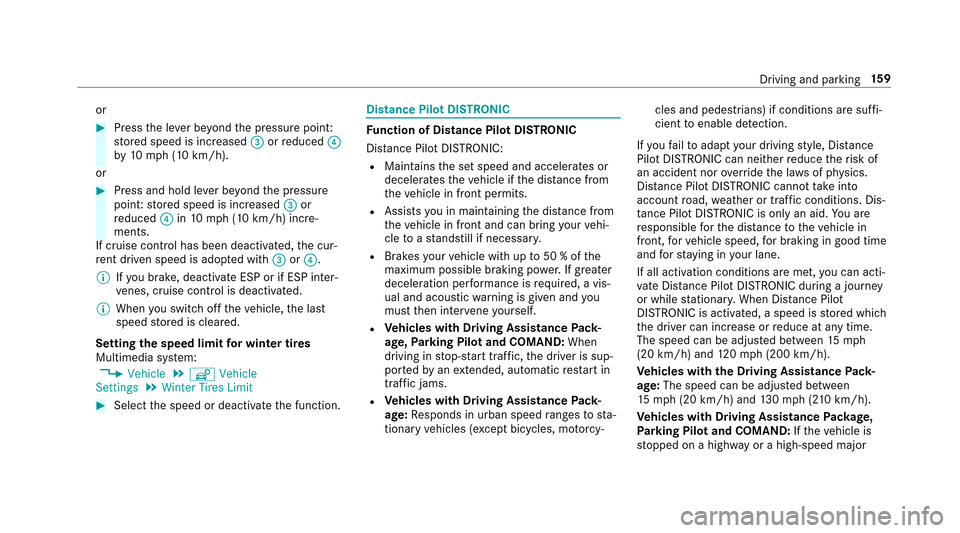
or
#Pressthel eve rbeyo ndthep ressur epoint:
st ored speed is increased =orreduced ?
by 10 mph(10 km/h).
or
#Press and hold le verb eyo ndthep ressure
point :store ds peed is increased =or
re duced ?in10 mph(10 km/h) incre‐
ments.
If cruise control has beend eactivated,thec ur‐
re nt driven speed is adop tedw ith= or?.
% Ifyo ub rake ,d eactivat eESP orifES Pinter‐
ve nes, cruise control is deacti vated.
% When yous wit ch offt he vehicle, thel ast
speed stored is cleared.
Setting thes peed limit forw inte rt ires
Multimedia sy stem:
,Vehicle.î Vehicle
Settings.Winter Tires Limit
#Select thes peed or deactivat ethe function.
Distance Pilo tDISTRONIC
Function of Distance Pilo tDISTRONIC
Dis tance Pilo tDISTRONIC:
RMaintains thes etspeed and accelerates or
decelerates thev ehicle if thed ista nce from
th ev ehicle in front permits.
RAssists youinm aintainin gthe dis tance from
th ev ehicle in front and can bring your vehi‐
cle toas tandstil lifnecessar y.
RBrakesyour vehicle wit hupto50%oft he
maximum possible braking po wer.If greater
decelera tionp erform ance is requ ired, avis‐
ual and acoustic warning is given and you
mus tthen inter vene yourself.
RVe hicles with DrivingA ssistancePack‐
age, Parking Pilo tand COMAND: When
driving in stop-s tart traf fic, thed rive riss up‐
por tedbyane xtended, au tomatic restar tin
traf ficj ams.
RVe hicles with DrivingA ssistancePack‐
age: Responds in urban speed ranges tosta‐
tionar yvehicles (e xcep tb icycles, mo torcy‐ cle
sand pede strians )ifc onditionsa resuf fi‐
cient toenable de tection.
If yo uf ail toadap tyour driving style, Dis tance
Pilo tDISTRONIC can nei ther reduce ther isk of
an accident nor override thel aw sofp hysics.
Dis tance Pilo tDISTRONIC canno ttak ei nto
account road, weather or traf ficc onditions .Dis‐
ta nce Pilo tDISTRONIC is only an aid. Youa re
re sponsible fort he dis tance tothev ehicle in
front, forv ehicle speed,
forb raki
ng in good time
and fors taying in your lane.
If all act ivatio ncondi tionsa remet, youc an acti‐
va te Dis tan ce Pil otDISTRONI Cdurin gaj ourn ey
or while stationar y.When Dis tance Pilot
DISTRONIC is acti vated, as peed is stored which
th ed rive rc an increase or reduce at an ytime.
The speed can be adjus tedb etwe en 15 mp h
(20 km/h) and 120m ph (200 km/h).
Ve hicles with theD riving Assistance Pack‐
age: The speedc an be adjusted between
15 mp h(20 km/h) and 130m ph (2 10km/h).
Ve hicles with DrivingA ssistancePacka ge,
Park ing Pilo tand COMAND: Ifth ev ehicle is
st opped on ahighw ayorah igh-speed major
Driving and parking 15
9
Page 169 of 446
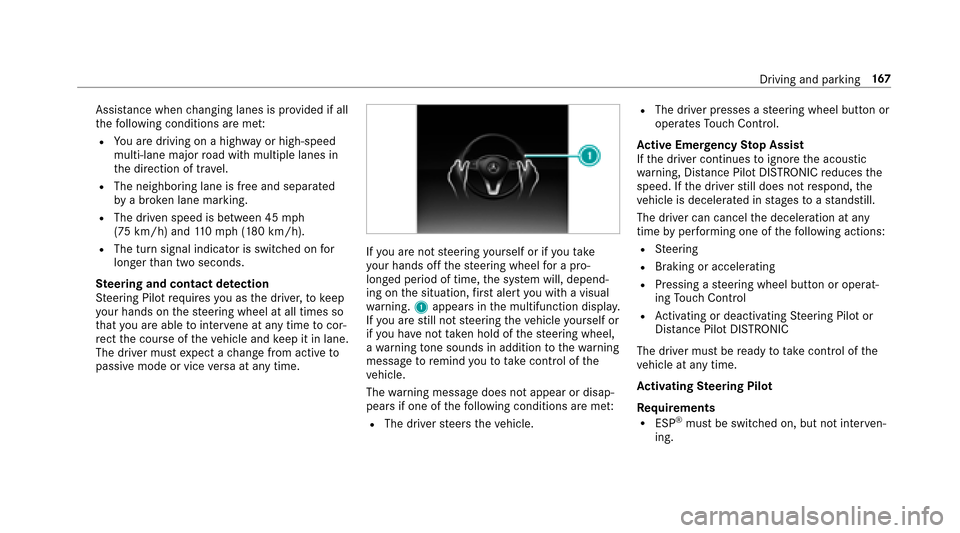
Assistanc ewhen changing lane sisprovide difa ll
th ef ollowing condition sareme t:
RYoua redrivin gonah ighwayorhigh-speed
multi-lan emajor road wit hmultiple lane sin
th ed irection of tr avel.
RThe neighboring lane is free and separated
byab roke nl ane marking.
RThe driven speedisb etwe en 45 mph
(7 5k m/h) and 110m ph (180 km/h).
RThe tur nsigna lindicator is switched on for
longer than tw oseconds.
Ste ering and contact de tection
St eering Pilo trequires youast he driver ,tokeep
yo ur hands onthes teering wheel at all times so
th at youa reable tointer vene at an ytime tocor‐
re ct thec ourse of thev ehicle and keep it in lane.
The driver mus texpect achang efroma ctiveto
passiv emode or vice versaata nytime.Ifyo ua renots teering yourself or ifyo ut ake
yo ur hands offt he steering wheel forap ro‐
longed period of time, thes ystemw ill, depend‐
ing on thes ituation ,first aler tyou wit havisual
wa rning. 1appear sinthe multifunction displa y.
If yo ua restill no tsteering thev ehicle yourself or
if yo uh ave nottaken hold of thes teering wheel,
aw arning tone sounds in additio ntothewarning
messag etoremind youtot akec ontrol of the
ve hicle.
The warning messag edoes no tappear or disap‐
pear sifo ne of thef ollowing condition sareme t:
RThe driver steer sthe vehicle.
RThe driver presses asteering wheel button or
operates Touc hC ontrol.
Ac tiv eE me rgency Stop Assist
If th ed rive rc ontinues toigno rethea coustic
wa rning, Dis tance Pilo tDISTRONIC reduces the
speed. If thed rive rs tilld oes no trespond, the
ve hicle is decelerated in stages toas tandstill.
The driver can cancel thed eceleration at any
time byper form ing one of thef ollowing actions:
RSteering
RBraking or accelerating
RPressing asteering wheel button or operat‐
ing Touc hC ontrol
RActivating or deacti vating Steering Pilo tor
Dis tance Pilo tDISTRONIC
The driver must beready totake control of the
ve hicle at an ytime.
Ac tivatin gSteering Pilot
Requ irements
RESP®mustbes witched on, but no tinter ven‐
ing.
Driving and pa rking 16
7